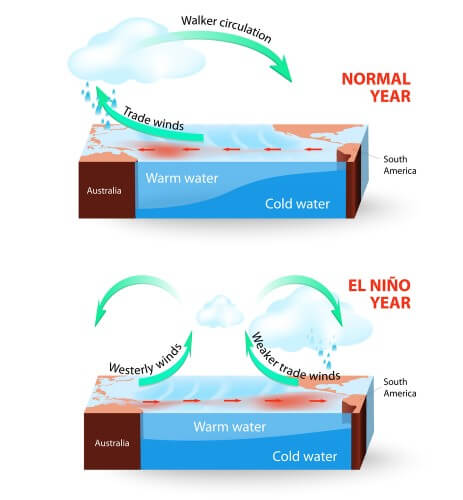The early signs indicate the El Nino phenomenon - the warming of the Pacific Ocean water, which affects the wind regime and thus also the rest of the world, will be strong. This may cause droughts in some places and floods in others. In Israel, a cold, rainy and even snowy winter is expected in the mountains

:
A year later than the early forecasts, an El Nino phenomenon begins to form in the Pacific Ocean.
El Nino (the child) is a well-known phenomenon in which the warming of the waters in the Pacific Ocean (mainly around the equatorial region) causes changes in the winds and currents in the ocean, which have a great impact on the entire world, such as drought in Australia, floods in East Africa, extreme dryness in Western America, and more.
According to preliminary signs such as the water temperature in the equatorial basin of the Pacific Ocean, El Niño conditions are developing starting in March of this year (2015). Since the warming has already exceeded the levels that were in previous El Niño periods and since the expectation is for an increase of about four degrees, it is expected that the accompanying phenomena caused by El Niño will be extreme to a degree that has not been seen in many years, some say about fifty years.
Since the expectation is for extreme phenomena that will cause damage to the food supply in many countries on three continents, the World Food Program (WFP) is publishing ten "guidelines" with a request for press in all ways, this in order to bring awareness that may mitigate the expected disasters.
According to the World Food Organization
- El Nino refers to a great warming of the waters of the Pacific Ocean.
- During El Niño, the relationship between the winds and currents in the ocean causes climatic changes in the entire world.
- Changes in rainfall and temperature affect food crops and pastures in large areas where the organization operates,
- El Nino events that have been observed since March 2015 are getting stronger. They will reach their peak at the end of 2015 and weaken starting at the beginning of 2016.
- There is a high probability that in the next 12 years the food supply will be affected among many populations in Central America, Sub-Saharan Africa and Southeast Asia that depend directly on agriculture and food.
- There are signs that a more powerful El Niño is developing than has been recorded to date.
- The impact on the production/growing of seeds/cereals in the countries can lead to an increase in prices, will harm the food supply for populations that anyway most of their income is directed to the purchase of food.
- The damage to the food supply will lead to an exacerbation of conflicts in areas where there is already unrest due to other factors such as damage to the quality of the land that leads to urbanization.
- The damage will be more acute in vulnerable populations due to the accumulation of other factors such as unsuccessful growing seasons in the recent past, which have already caused "adaptation" to harmful behavior patterns such as: skipping/giving up meals, taking children out of school or selling assets
- הThe organization (WFP) will "stretch" its activities in 2016 when the impacts of El Niño will become clear and the need for food aid in the various regions will become clear.
So far translation) of the publication of the World Food Organization. Will it help prevent disasters?
The effect of the El Nino phenomenon on Israel manifests itself in cold, rainy and snowy winters, is anyone preparing?

One response
"The effect of the El Niño phenomenon on Israel manifests itself in cold, rainy and snowy winters, is anyone preparing?"
Where did you hear about it? I've heard of a weak correlation, if any.